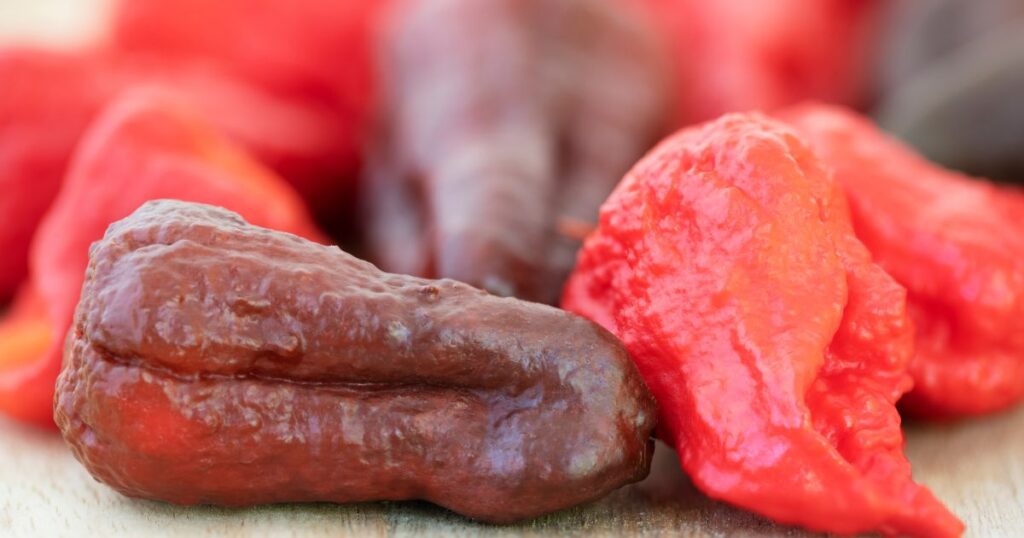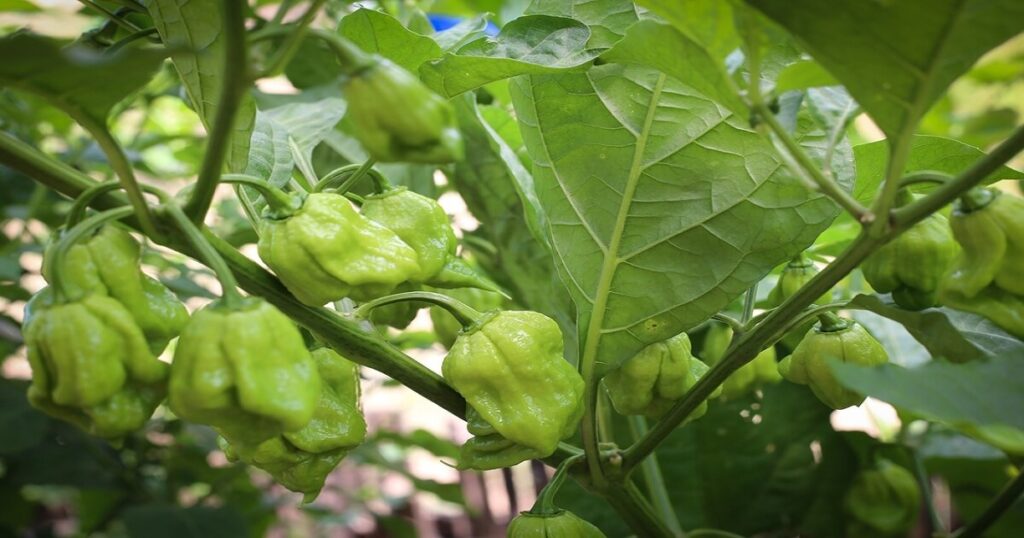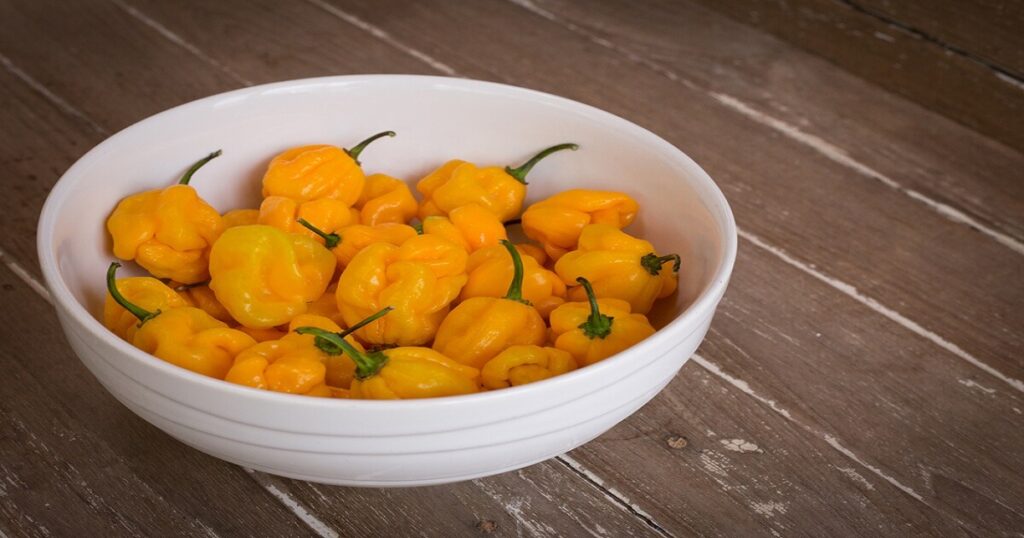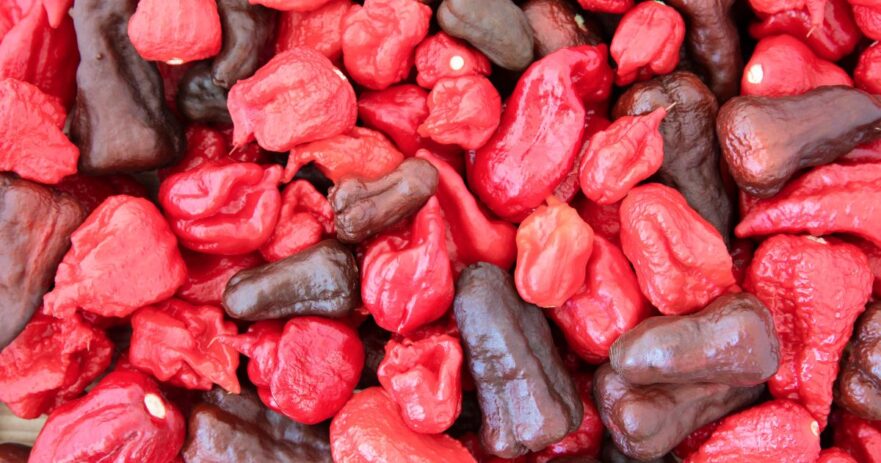In this article about naga viper pepper:
🗺️ Origin and history | 🌶️ Uses | ✨ Appearance and taste | 🧑🌾 Growing – gardening | 👨🍳 Cooking – recipes | 🛒 Where to buy | 🫙 How to store | 👨⚕️ Health benefits | 🌶️ Alternatives and substitutes | ❓ Frequently asked questions
What is the Naga Viper pepper?
The Naga Viper pepper is an exceptionally fiery chili pepper hybrid, a cross between three well-known hot peppers: the Naga Morich, Bhut Jolokia, and Trinidad Scorpion. Created in the United Kingdom by chili farmer Gerald Fowler, this intense pepper has made global headlines due to its extraordinary heat.
Naga Viper peppers are characterized by their distinct wrinkled appearance and vibrant red color upon reaching full maturity. In addition, they have a unique flavor that combines a fruity undertone with an intense, slow-building heat.
| Naga Viper | |
| SHU | 1,382,118 - 1,382,118 |
| Median SHU | 1,382,118 |
| Flavor | Sweet, fruity, tangy with a very intense heat |
| Species | Hybrid of Capsicum chinense x Capsicum frutescence |
| Origin | United Kingdom |
| Uses | Hot sauces, barbecue sauces, curries, stir-fries etc. |
Are Naga Viper peppers spicy? How hot are they?
Naga Viper Scoville: 1,382,118 SHU
The Naga Viper pepper is an extraordinarily spicy chili, boasting a Scoville rating of 1,382,118 SHU. This staggering intensity positions it as one of the world’s hottest peppers. By comparison, the jalapeño pepper typically ranges from 2,500 to 8,000 SHU, which is a far cry from the Naga Viper’s fierce heat.
To offer further context, the infamous Carolina Reaper pepper, known as one of the spiciest peppers worldwide, has a Scoville rating of 1,400,000 to 2,200,000 SHU. While not quite reaching this extreme, the Naga Viper still delivers a heat level that demands respect and careful handling.
🗺️ ORIGIN AND HISTORY

Where does the Naga Viper pepper come from?
The Naga Viper pepper is a relatively new addition to spicy peppers, originating in the United Kingdom. Gerald Fowler, a British chili pepper grower from the Chili Pepper Company in Cumbria, England, first cultivated it.
The Naga Viper is a hybrid comprising three chili peppers – the Naga Morich, Bhut Jolokia (ghost pepper), and the Trinidad Scorpion, all renowned for their formidable heat. The cross-breeding of these three powerhouses resulted in the Naga Viper, a pepper that briefly held the title of the world‘s hottest chili in 2011.
🌶️ USES
What are Naga Viper peppers good for? How to use them?
Naga Viper peppers are the choice for those seeking a formidable punch of heat in their dishes. The intense spiciness of Naga Viper peppers makes them excellent for salsas, sauces, and marinades, where their flavor profile can take center stage. In addition, the Naga Viper chili sauce is a popular condiment that delivers explosive heat and complex flavor, making it a perfect companion for grilled meats and other dishes.
Moreover, such peppers can add a new dimension of heat and flavor to stews and soups. So, whether creating a traditional Indian curry or spicy chili, finely chopped Naga Vipers can transform the dish, infusing it with an invigorating heat that will enliven your taste buds.
✨ APPEARANCE AND TASTE
What does a Naga Viper pepper look like?
Naga Viper peppers possess a distinct, elongated shape. They typically range from 2 to 3 inches in length. As they ripen, their color transforms from a vibrant green to a fiery red, contributing a visual pop to any dish they adorn. In addition, the exterior of the Naga Viper pepper is characterized by a slightly wrinkled texture, which adds to its unique appearance.
What do Naga Vipers taste like?
Naga Viper peppers offer a remarkable flavor experience, combining an intense, scorching heat with a subtly sweet and fruity undertone. Their extreme heat is attributed to their substantial capsaicin content, the compound responsible for the spicy sensation. As a result, some enthusiasts compare the taste of Naga Vipers to a fruity sweetness with a hint of tanginess.
🧑🌾 GROWING – GARDENING

How to grow Naga Viper peppers?
With their intense heat and unique flavor, Naga Viper peppers are an exciting choice for garden enthusiasts who enjoy cultivating their chili peppers. They flourish in regions with warm temperatures and ample sunlight, making them suitable for areas with extended, heat-drenched growing seasons. Naga Vipers can be grown both in containers and directly in the soil.
Proper soil drainage, as is a consistent watering routine, is crucial for cultivating these peppers. In addition, regular applications of fertilizer throughout the growing period can further boost their growth and yield.
When are Naga Viper peppers ready to pick?
Picking Naga Viper peppers at the right time ensures maximum flavor and heat. However, reaching full maturity usually takes between 100 to 150 days. Therefore, the optimal time to harvest is when they have achieved their vibrant red hue, indicating they have developed their full flavor profile and heat intensity.
👨🍳 COOKING – RECIPES
Cooking / Recipe ideas for Naga Viper
With its extreme heat and distinctive flavor, the Naga Viper pepper offers many culinary possibilities for those who love a spicy kick. This ultra-hot chili pepper can be used in multiple forms, including Naga Viper chili sauce, fruity Naga Viper salsa, or its dried, powdered state.
One of the most popular uses for the Naga Viper is making a chili sauce that packs explosive heat. Blend fresh Naga Viper peppers with garlic, onion, spices, vinegar, and honey or sugar to balance the heat. The resulting Naga Viper chili sauce is a fiery addition to various dishes, ranging from grilled meats to stir-fries and breakfast scrambles.
A fruity Naga Viper salsa is a fantastic choice for a touch of sweetness to balance their intense heat. Combine the Naga Vipers with sweet and tangy ripe mangoes or pineapple notes. This flavorful salsa is perfect for topping grilled fish, as a zesty dipping sauce, or as a vibrant addition to tacos.
Powdering dried Naga Viper peppers creates a fiery spice that adds depth and heat to various dishes. Sprinkle the Naga Viper powder on roasted vegetables, pasta, or popcorn for an extra spicy kick. Dried peppers can also be rehydrated and used in salsas, stews, or sauces, proving their versatility.
However, extreme caution in handling Naga Viper peppers in the kitchen is crucial due to their intense heat. Always use gloves to prevent skin irritation, and avoid touching your face, especially your eyes, as the capsaicin in the peppers can cause severe discomfort.

🛒 WHERE TO BUY
Where can I buy Naga Viper peppers?
Securing Naga Viper peppers for your spicy culinary creations may require more searching than for common chilies. Fresh or dried Naga Vipers may be available in specialty grocery stores or local farmer’s markets known for their unique produce. Moreover, many online retailers offer these super-hot peppers, ensuring delivery straight to your home.
Opt for a vibrant color and firm feel when picking fresh Naga Viper peppers. Steer clear of wrinkled, soft, or blemished peppers, as these may be beyond their peak. If you’re considering dried Naga Vipers, ensure they are mold free and stored in a cool, dry area.
Where can I buy Naga Viper plants?
If you want to grow Naga Viper pepper plants, you can acquire them from select garden centers or nurseries specializing in chili plants. In addition, numerous online retailers sell Naga Viper plants. Choose plants with robust stems and vibrant green foliage, and avoid those that are wilting or yellowing.
Where can I buy Naga Viper seeds?
Seeds can be obtained from specific garden centers or online vendors for gardening enthusiasts who wish to cultivate Naga Viper peppers from seed. When sowing Naga Viper seeds, follow the guidelines provided on the seed packet. They need a sunny spot and well-drained soil. You’ll soon be harvesting Naga Viper peppers.
🫙 HOW TO STORE
How do I store Naga Viper peppers?
Fresh Naga Viper peppers can be stored to prolong their freshness and utility. Place the peppers in a ventilated plastic bag or a sealed container in the refrigerator’s crisper drawer. If stored correctly, these super-hot peppers can maintain their quality for up to two weeks.
Naga Viper pepper sauces can be refrigerated for several months. Keep Naga Viper sauce in its original packaging or relocate it to a sealed container for refrigeration. Ensure the container is tightly sealed to prevent the peppers from spoiling.
Can Naga Viper peppers be frozen?
Naga Viper peppers can be frozen for extended storage. After thoroughly washing the peppers and removing their stems and seeds, arrange them in a single layer on a baking sheet and freeze for several hours. Once frozen solid, transfer the peppers to a sealed container or freezer-safe plastic bag; they can be stored for up to six months.
❤️🩹 HEALTH BENEFITS
Are Naga Viper peppers healthy?
Naga Viper peppers pack a serious heat alongside an array of health benefits. They are low in calories and high in dietary fiber, complemented by a selection of key vitamins and minerals, such as vitamins C, A, and potassium. However, given their extreme heat, consuming Naga Viper peppers in large quantities for their nutritional benefits isn’t practical, and they should not be relied upon as a primary source of vitamins.
The capsaicin in these peppers offers various health advantages, including anti-inflammatory, analgesic, and metabolism-boosting properties. However, the intense heat of capsaicin can also lead to gastrointestinal discomfort for some. So, while the health benefits of Naga Viper peppers are substantial, their extreme spiciness means they should be consumed sparingly. If consuming them causes discomfort, reducing intake or avoiding these fiery peppers may be necessary.
🔄 ALTERNATIVES AND SUBSTITUTES
What’s a suitable alternative to Naga Viper pepper?
As one of the hottest peppers, finding a direct alternative to the Naga Viper pepper can be challenging. However, the Trinidad Moruga Scorpion pepper offers a similar heat and fruity flavor, making it a decent substitute in recipes that call for Naga Viper.
Ghost Peppers (Bhut Jolokia) can serve as a less intense alternative. While they still carry significant heat, Naga Vipers are more spicy. Yet, they maintain a unique, fruity flavor and light sweetness, making them suitable for various dishes like salsas and hot sauces.
Habanero peppers, another less fiery option, offer a fruitier, tangy flavor with a substantial kick, suitable for those who prefer a balance of flavor and spiciness. However, remember to adjust the quantity based on your heat preference. After all, Habaneros are still quite spicy compared to typical chili peppers.
Finally, Scotch Bonnet peppers, known for their taste and heat similar to Habaneros, can be a good substitute in dishes with a sweet, tropical flavor and a decent heat level. As always, adjust the quantity to suit your tolerance to spice.
How do you pronounce Naga Viper pepper?
Naga Viper pepper is pronounced NAH-gah VY-per.
🙋 FREQUENTLY ASKED QUESTIONS
FAQ about naga viper peppers
Is the Naga Viper pepper hot?
The Naga Viper pepper is incredibly hot. It‘s one of the hottest peppers in the world. It measures a staggering 1,382,118 Scoville Heat Units (SHU), the unit of measurement used to quantify the spiciness of chili peppers. This heat level makes the Naga Viper hotter than habanero and ghost peppers. However, it's not just the heat that makes it stand out; its distinct fruity flavor accompanies the spiciness.
What’s the difference between Naga Viper pepper and Carolina Reaper pepper?
The Naga Viper and the Carolina Reaper peppers are among the hottest in the world, but the Carolina Reaper holds the record for being the spiciest. In this way, the Carolina Reaper ranges between 1,400,000-2,200,000 SHU, while the Naga Viper pepper registers at 1,382,118 SHU.
Does consuming Naga chili have side effects?
Consuming Naga Viper peppers, like any extremely hot chili pepper, can have side effects, particularly for those not accustomed to such high levels of spiciness. These can include immediate mouth and throat burn, sweating, flushing of the face, and watery eyes. Some people may also experience stomach discomfort, nausea, and vomiting. Moreover, capsaicin, the compound that makes peppers hot, can irritate the skin and eyes, so ‘handling these peppers carefully is important.
What’s the difference between a Naga chili and a Scotch Bonnet?
Naga Viper and Scotch Bonnet peppers differ greatly in heat level and flavor profile. The Naga Viper is one of the world‘s hottest peppers, registering at 1,382,118 SHU. Meanwhile, the Scotch Bonnet has a significantly lower heat level, typically between 100,000 and 350,000 SHU. Flavor-wise, both peppers are fruity, but the Scotch Bonnet is often described as having a slightly sweeter, more tropical taste compared to the Naga Viper. This makes Scotch Bonnets a preferred choice for a plethora of Caribbean dishes. At the same time, Naga Vipers are typically used in extremely hot sauces and curries.
